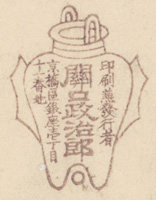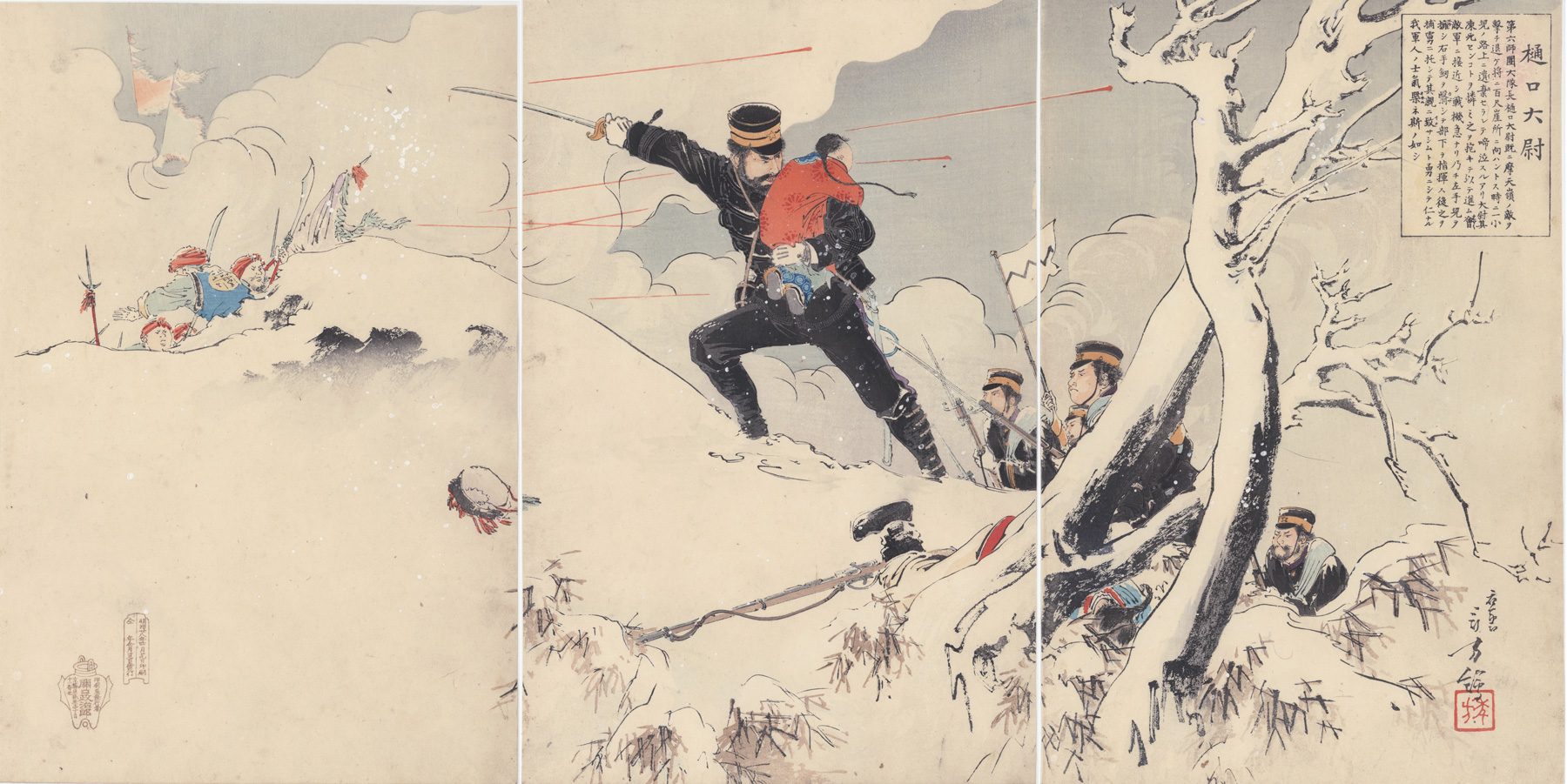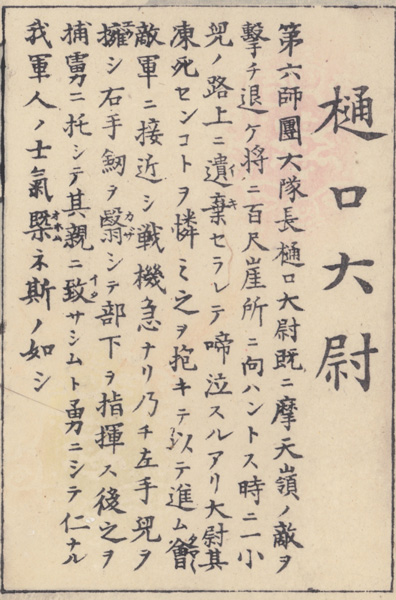About This Print
The brave Captain Higuchi was celebrated in prints, in song and in writing. [Also see IHL Cat. #1811 Captain Higuchi, in the Midst of the Attack, Personally Holds a Lost Chinese Child by Ogata Gekkō (1859-1920) and IHL Cat. #2163 The Attack on Weihaiwei: The Taking of the Hundred Foot Cliff [Captain Higuchi saves a child] by Watanabe Nobukazu (c.1872-1944).] Rescued Chinese babe in arm, sword in hand, he leads the charge across the snow to attack the Chinese enemy during a battle near Weihaiwei.
How much myth is mixed with reality in the portrayals and retelling of this incident is unclear, but the following 1895 "absolutely authentic" account titled "That Baby" by a British writer is typical:1
last revision:
...some of the soldiers found a well-nourished Chinese baby boy lying on the ground, and it was supposed that the child belonged to the woman who had just been sent beyond the lines. Pitying the little fellow, who was crying bitterly, Captain Higuchi Seizaburo, of the Sixth Division, picked him up and did his best to console the baby. But as the young Chinaman refused to be comforted. Captain Higuchi called up one of the prisoners and told him that he, the Captain, would give him his liberty if he took that baby to its parents. To this the Chinese captive, a stalwart fellow who looked as if he might have children himself, joyfully consented; but the baby refused to be separated from its Japanese friend, and cried harder than ever when the Chinese tried to take it in his arms. So, holding the baby in his left arm while he grasped his sabre with the right, Captain Higuchi marched to the capture of the next fort, receiving at one time a bullet through his cap. The fort was taken in gallant style, the baby meanwhile looking on in wondering surprise at the din and uproar of the battle, perfectly content to rest on the kind-hearted Captain's shoulder. When all was over this gallant officer gave his tiny charge to some of his troopers, who bore the child in safety to a Chinese house in a village hard by.2
In commenting on this incident historian John W. Dower notes:
click on image to enlarge | The inscription reads: Captain Higuchi After having destroyed and conquered the enemy at Motianling [Fort], and while pushing forward towards the "Hundred -Foot-Cliff," the battalion commander of the Sixth Brigade, Captain Higuchi, found an abandoned Chinese infant crying on the ground. Taking pity on the child and worried that it might freeze to death, he picked up the child and continued to advance. Unexpectedly, Higuchi ran into the enemy and realized that he had to fight. He then embraced the child with his left arm and raised his sword with his right arm, leading his men. Afterwards he gave the child to a Chinese prisoner who returned it to the parents. In general, [these actions] exemplify the spirit of our brave and virtuous soldiers. |
1 The preface of Heroic Japan: A History of the War Between China & Japan states that the information in the book is "absolutely authentic; for not only have the Imperial Household, Foreign, War, and Navy Departments given the authors free access to all documents, but every word in the book has been thoroughly and repeatedly revised by the Authorities concerned, several chapters having thus been written and re-written six and even more times."
2 Heroic Japan: A History of the War Between China & Japan, F. Warrington Eastlake and Yamada Yoshi-aki, Sampson Low, Marston & Company, 1897, p. 333-334.
3 website MIT Visualizing Culture: Throwing Off Asia II Woodblock Prints of the Sino-JapaneseWar (1894-1895) by John W. Dower http://ocw.mit.edu/ans7870/21f/21f.027/throwing_off_asia_01/compassionate_hero.html
3 website MIT Visualizing Culture: Throwing Off Asia II Woodblock Prints of the Sino-JapaneseWar (1894-1895) by John W. Dower http://ocw.mit.edu/ans7870/21f/21f.027/throwing_off_asia_01/compassionate_hero.html
Print Details
| IHL Catalog | #1343 |
| Title or Description | Captain Higuchi 樋口大尉 Higuchi taii |
| Artist | Mizuno Toshikata (1866-1908) |
| Signature |  |
| Seal | 年方 Toshikata (see above) |
| Publication Date |  仝 年仝月廿三日発行 published: April 23, 1895 |
| Publisher |  |
| Impression | excellent |
| Colors | excellent |
| Condition | good - three separate sheets; trimmed to image; soiling; remnants of previous backing |
| Genre | ukiyo-e; senso-e (Sino-Japanese War) |
| Miscellaneous | |
| Format | vertical oban triptych |
| H x W Paper | 13 3/4 x 9 in. (35 x 22.9 cm) approx. each sheet |
| Literature | Japan at the Dawn of the Modern Age – Woodblock Prints from the Meiji Era, Louise E. Virgin, Donald Keene, et. al., MFA Publications, 2001, p.102, pl. 54; In Battle's Light: Woodblock Prints of Japan's Early Modern Wars, Elizabeth de Sabato Swinton, Worcester Art Museum, 1991. p. 80, pl. 45; Conflicts of Interest: Art and War in Modern Japan, Philip K. Hu, et. al., Saint Louis Museum of Art, 2016, p. 146-147, pl. 52 |
| Collections This Print | Museum of Fine Arts, Boston 2000.439a-c; Saint Louis Museum of Art 144.2010a-c |
4/15/2020



